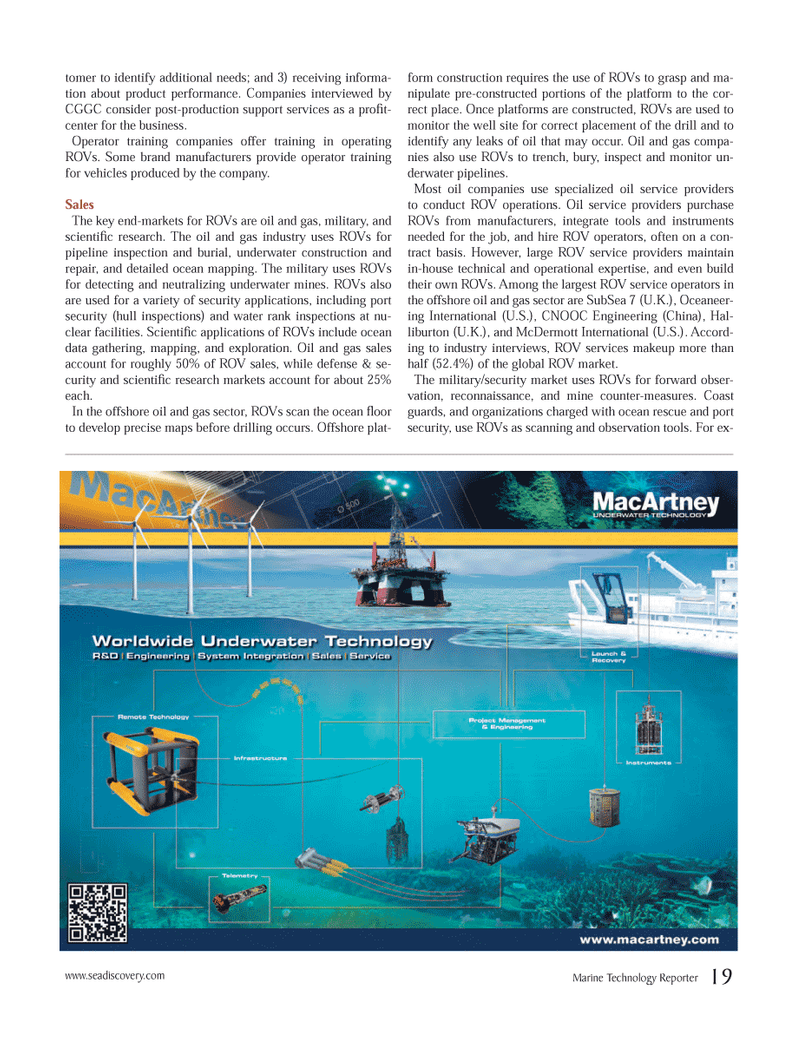
Page 19: of Marine Technology Magazine (June 2012)
AUV Arctic Operations
Read this page in Pdf, Flash or Html5 edition of June 2012 Marine Technology Magazine
tomer to identify additional needs; and 3) receiving informa- tion about product performance. Companies interviewed by CGGC consider post-production support services as a proÞ t-center for the business. Operator training companies offer training in operating ROVs. Some brand manufacturers provide operator training for vehicles produced by the company. SalesThe key end-markets for ROVs are oil and gas, military, and scientiÞ c research. The oil and gas industry uses ROVs for pipeline inspection and burial, underwater construction and repair, and detailed ocean mapping. The military uses ROVs for detecting and neutralizing underwater mines. ROVs also are used for a variety of security applications, including port security (hull inspections) and water rank inspections at nu- clear facilities. ScientiÞ c applications of ROVs include ocean data gathering, mapping, and exploration. Oil and gas sales account for roughly 50% of ROV sales, while defense & se- curity and scientiÞ c research markets account for about 25% each.In the offshore oil and gas sector, ROVs scan the ocean ß oor to develop precise maps before drilling occurs. Offshore plat- form construction requires the use of ROVs to grasp and ma- nipulate pre-constructed portions of the platform to the cor- rect place. Once platforms are constructed, ROVs are used to monitor the well site for correct placement of the drill and to identify any leaks of oil that may occur. Oil and gas compa- nies also use ROVs to trench, bury, inspect and monitor un- derwater pipelines. Most oil companies use specialized oil service providers to conduct ROV operations. Oil service providers purchase ROVs from manufacturers, integrate tools and instruments needed for the job, and hire ROV operators, often on a con- tract basis. However, large ROV service providers maintain in-house technical and operational expertise, and even build their own ROVs. Among the largest ROV service operators in the offshore oil and gas sector are SubSea 7 (U.K.), Oceaneer- ing International (U.S.), CNOOC Engineering (China), Hal-liburton (U.K.), and McDermott International (U.S.). Accord- ing to industry interviews, ROV services makeup more than half (52.4%) of the global ROV market. The military/security market uses ROVs for forward obser- vation, reconnaissance, and mine counter-measures. Coast guards, and organizations charged with ocean rescue and port security, use ROVs as scanning and observation tools. For ex- Marine Technology Reporter 19www.seadiscovery.com MTR #5 (18-33).indd 19MTR #5 (18-33).indd 195/31/2012 9:52:26 AM5/31/2012 9:52:26 AM

 18
18

 20
20
